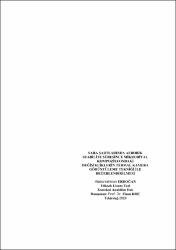| dc.contributor.author | Erdoğan, Abdurrahman | |
| dc.date.accessioned | 2020-02-05T07:50:41Z | |
| dc.date.available | 2020-02-05T07:50:41Z | |
| dc.date.issued | 2019 | |
| dc.identifier.uri | https://hdl.handle.net/20.500.11776/3573 | |
| dc.description.abstract | Araştırmanın ana amacı; Termal Kamera Görüntüleme Tekniğinin, silajdaki aerobik dönemde meydana gelen bozulmanın boyutları hakkında güvenilir ve pratik bir ölçü aracı olarak kullanılıp kullanılamayacağını tespit etmektir. Aerobik stabilite (silo ömrü), açılan bir silajın ısınmadan ve bozulmadan kaldığı sürenin uzunluğu olarak tanımlanmaktadır. Aerobik stabilite kompleks bir süreç olup, silolanan ürünün mikrobiyal bileşimi, fermantasyon özellikleri, silaj kütlesinin sıcaklığı ve silaj yoğunluğu oluşabilecek kayıpları etkilemektedir. Yemleme döneminde silaj kalitesinin mikrobiyolojik ve kimyasal analizlerle değerlendirilmesi kalifiye personel, ekipman ve laboratuar gerektirirken, aynı zamanda pahalı ve zaman alıcıdır. Fiziksel analizler de çoğu zaman yemdeki bozulmanın boyutlarının saptanması için yeterli değildir. Araştırma Tekirdağ ilinde mısır silajı yapan bir işletmede yürütülmüştür. Bu amaçla toprak üstü silonun yüzey alanı (sağ, orta ve sol bölge) olmak üzere 3 örnekleme bölgesine ayrılmıştır. Her bir bölgedeki sıcaklık değerleri ve ortam sıcaklığı 40 gün süreyle sıcaklık sensörleri ile ölçülüp kaydedilmiştir. Araştırmanın 0., 7., 14., 21. 30. ve 40. günlerinde silonun belirlenen 3 farklı noktasından 5 tekerrür olmak üzere alınan silaj örneklerinde kimyasal ve mikrobiyolojik parametrelere ilişkin analizler yürütülmüştür. Aynı zamanda, Fluke Ti9 IR (160x120) marka termal kamera ile 1 m mesafeden silo yüzeyinin belirlenen bölgelerinden görüntüleme yapılarak değerlendirme sonuçları kaydedilmiştir. Daha sonra elde edilen veriler SmartView®software programında değerlendirilmiştir. Araştırma sonucunda, termal kamera görüntüleme tekniği ve sıcaklık sensörlerine ilişkin değerlerin paralellik gösterdiği tespit edilmiştir. Ayrıca termal kameranın, aerobik stabilitenin erken döneminde bozulmanın boyutlarını belirleyebilmek ve silaj amenajmanını geliştirmek amacı ile saha şartlarında pratik bir yöntem olarak kullanılabileceği sonucuna varılmıştır | en_US |
| dc.description.abstract | The main purpose of the research is to determine whether Thermal Camera Imaging Technique can be used as a reliable and practical means of measurement tool about the extent of spoilage occurred in silage during the aerobic period. The aerobic stability (silo process) is defined as the length of time that silage remains cool and does not spoil after it is exposed to air. Aerobic stability is a complex process where microbial composition of the ensiled product, properties of fermentation, silage mass temperature and silage density affect the intensity of the loss that may occur. The evaluation of silage quality through microbiological and chemical analyses during the feeding period requires qualified staff, equipment and laboratory as well as being expensive and time consuming. Physical analysis alone is often not sufficient to determine the degree of deterioration in forage. The research was carried out in a silage plant in the city of Tekirdağ. For this purpose, the surface area of the overlying silo is divided into 3 sampling regions (right, middle and left region). Temperature values and ambient temperature in each zone were measured and recorded through temperature sensors for 40 days. Analysis regarding chemical and microbiological parameters was carried out on silage samples taken from 3 different fixed points of the silo at the 0th, 4th, 7th, 14th, 21st and 40th days of the study. At the same time, the Fluke Ti9 IR (160x120) thermal imaging camera was used at a distance of 1 meter to record imaging from constant points in the silo surface and thus the result assessment was ascertained. The data obtained are then evaluated in the SmartView®software program. As a result, it was determined in this study that the values regarding thermal camera imaging technique and temperature sensors were parallel. In addition, it was concluded that the thermal imager can be used as a practical method in the field conditions to determine the dimensions of deterioration in the early period of aerobic stability and to improve the silage management | en_US |
| dc.language.iso | tur | en_US |
| dc.publisher | Namık Kemal Üniversitesi | en_US |
| dc.rights | info:eu-repo/semantics/openAccess | en_US |
| dc.subject | Aerobik stabilite | en_US |
| dc.subject | silaj sıcaklığı | en_US |
| dc.subject | mikrobiyal kompozisyon | en_US |
| dc.subject | kızılötesi (Infrared/IR) termografi tekniği | en_US |
| dc.subject | Aerobic stability | en_US |
| dc.subject | silage temperature | en_US |
| dc.subject | microbial composition | en_US |
| dc.subject | infrared thermography technique | en_US |
| dc.title | Saha şartlarında aerobik stabilite sürecinde mikrobiyal kompozisyondaki değişikliklerin termal kamera görüntüleme tekniği ile değerlendirilmesi | en_US |
| dc.title.alternative | EVALUATION OF THE CHANGES IN MICROBIAL COMPOSITION IN FARM CONDITIONS DURING AEROBIC STABILITY USING THERMAL CAMERA IMAGING TECHNIQUE | en_US |
| dc.type | masterThesis | en_US |
| dc.department | Enstitüler, Fen Bilimleri Enstitüsü, Zootekni Ana Bilim Dalı | en_US |
| dc.relation.publicationcategory | Tez | en_US |



















